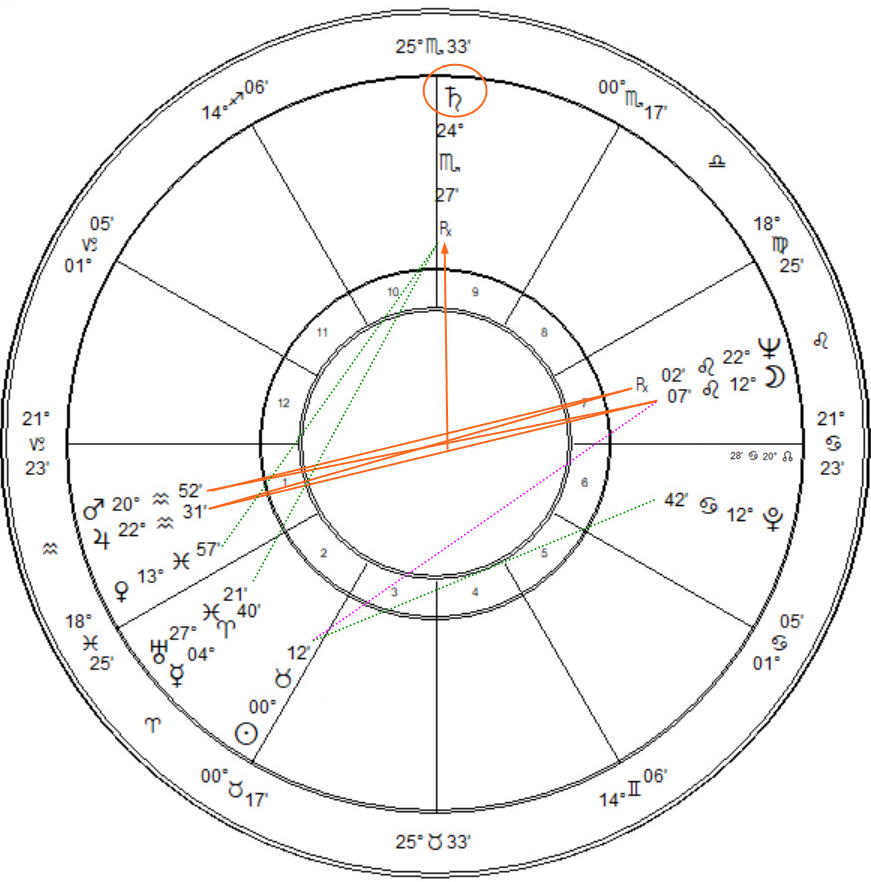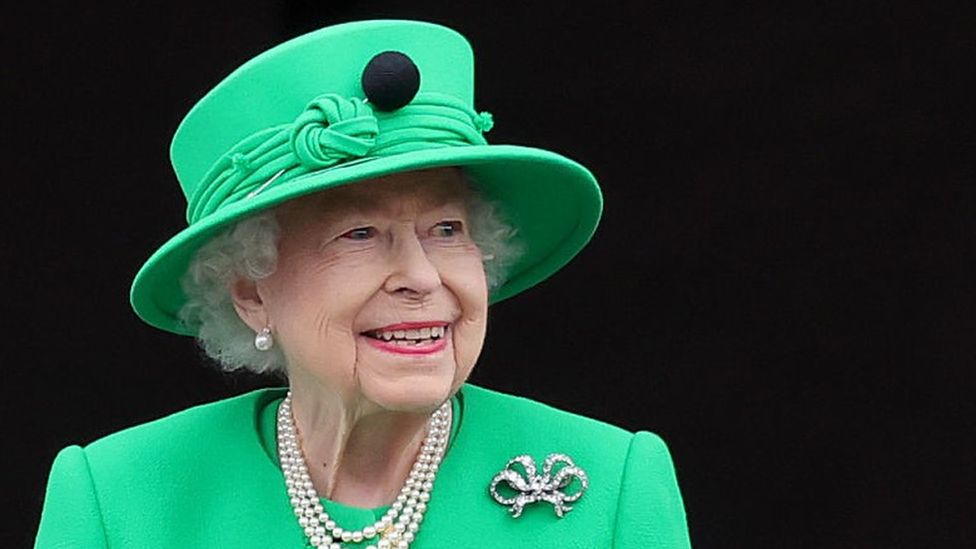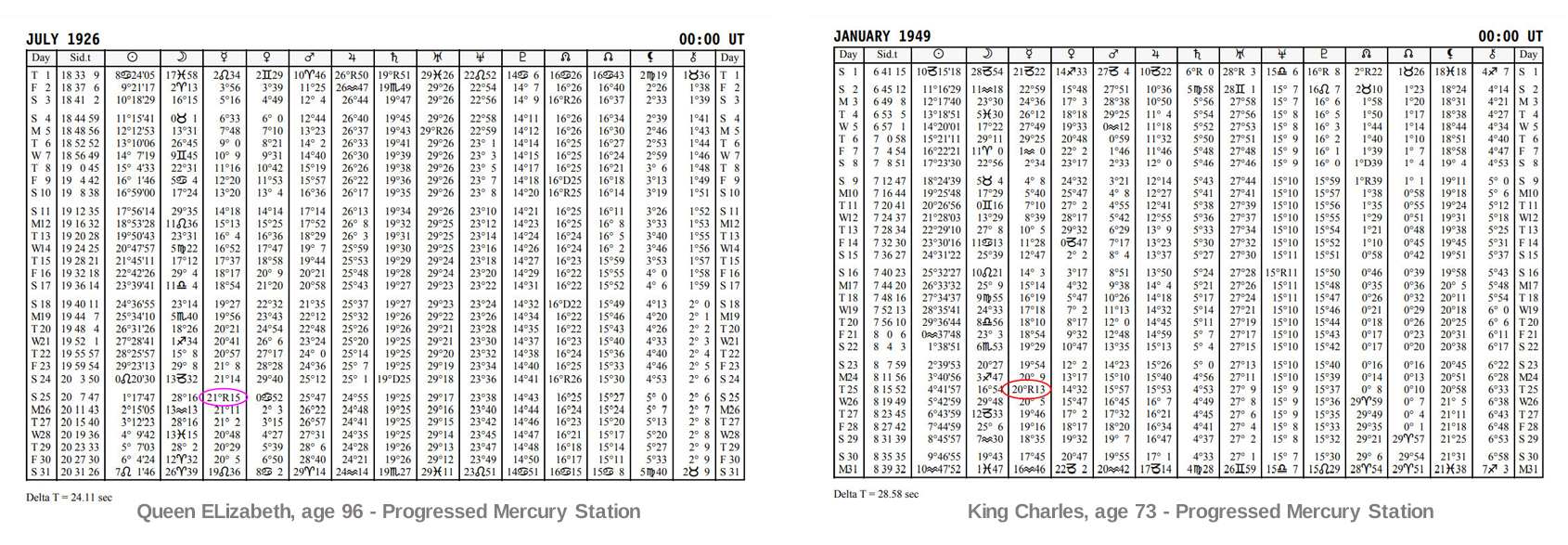Orbiting planets work in pairs of positive and negative expression. Astrologers often pair the planets but differ in their choice of couplings. Queen Elizabeth II was born on April 21, 1926 at 2:40 am in London, England. The planetary pairs used in the analysis of the Queen’s chart are those defined by Marc Edmund Jones. The pairs are the Sun and Moon, the planets of Vitality; Mars and Venus the planets of Efficiency; Jupiter and Saturn, the planets of Motivation; and Uranus and Neptune, the planets of Significance. The planetary pairs are used to determine what Jones calls the Mode of Self-Integration.1 The technique reveals the way in which an individual integrates their talents and abilities with the opportunities their environment offers.
The graph on page 154 of Jones’ Essentials of Astrological Analysis assists in determining which psychological approach an individual should adopt in the pursuit of their life objectives. The six possible modes of integration with the physical world are personal or impersonal circumstances determined by an emphasis of the houses, subjective or objective function defined by the signs and disjunctive or conjunctive activity defined by the planets. The planetary pairs are applied to the graph with the results offering the best means to accomplish one’s goals.
The simplest indication in a chart for integrating the self within society is when two of the planetary pairs form major aspects and two do not. This ideal balance in the psyche facilitates individuals with a clear, outward direction of intent. A mental imbalance can occur when three or all pairs are found in  major aspect. It can cause a need for the native to take more time in the orientation of their approach in the process of accomplishing goals. The difficulty arises when a plethora of thoughts vie for attention within the mind, thus canceling out what would otherwise be simple decision-making under the ideal of only two of the four pairs in major aspect. When no pairs are in major aspect there is an under stimulation of initiative, with a resulting feeling of ineptitude and lack of direction in general. When no pairs are aspected, or when one, three or all pairs are in major aspect, a dominant two pairs can be identified through symmetry2 within the overall planetary patterning.
major aspect. It can cause a need for the native to take more time in the orientation of their approach in the process of accomplishing goals. The difficulty arises when a plethora of thoughts vie for attention within the mind, thus canceling out what would otherwise be simple decision-making under the ideal of only two of the four pairs in major aspect. When no pairs are in major aspect there is an under stimulation of initiative, with a resulting feeling of ineptitude and lack of direction in general. When no pairs are aspected, or when one, three or all pairs are in major aspect, a dominant two pairs can be identified through symmetry2 within the overall planetary patterning.
The Queen’s Mode of Self-Integration
Queen Elizabeth’s chart shows the ideal situation with two pairs that are in major aspect and two that are not. The pairs in major aspect are Jupiter-Saturn and the Sun-Moon. This defines subjective function as the Queen’s Mode of Self-Integration. The Queen, although very young when first ascending the throne, became a monarch who rose to the occasion primarily with a reliance on subjective values with the desire to follow the dictates of her own mind and heart. She accepted her royal role with an ease of alignment of inner and outer rapport, and for the most part, kept her own council throughout her long reign. She most likely from early childhood, ruminated about the possibility of taking on grave responsibilities at some point in her life, and the inner poise with which she accepted her duties gives testimony to a well-balanced subjective functioning in consciousness.
The T Cross
The oppositions from the 1st to the 7th house of the chart are intercepted and allow the Queen to be discreet and avoid the public display of any conflicts between herself and others. The north and south nodes rest on the ascendant-descendant meridian. The north node in the 7th house points her attention toward the direct interaction with others and downplays any over-concern with personal needs that the 1st house represents.
Both opportunities and challenges are created by the polarization of planets from the 1st to 7th houses. The tension created by these multiple oppositions has its release through Saturn elevated at the Midheaven and in square aspect with the four planets forming the foundational opposition aspect to which Saturn becomes the outlet of energies.
King George VI died unexpectedly when the 25-year-old princess was in Kenya on a tour of the Commonwealth. When it came time for her to give up her personal involvements, she willingly and responsibly took on the role that was thrust upon her. Her father is symbolically reflected in the planet Saturn, which rules the paternal figure, and its placement in tight conjunction with the Midheaven shows the potential for worldly power. The planet is in High Focus when both conjunct the Midheaven and elevated but is also in Point Focus of the powerful T Cross. Undoubtedly, Saturn represents the signature mark of rulership shown in the chart. This powerful potential could have been recognized from birth by any knowledgeable astrologer. Saturn’s dominant position in the chart revealed a destiny to wield power and influence at some point in the Queen’s life.
The Sharp Destiny
When Jupiter and Saturn, the planetary pair of Motivation, form a conjunction, square or opposition aspect, they create what Jones calls a Sharp Destiny.3 A person with one of these three “hard” aspects in their chart is compelled, in three distinct ways, to live up to their highest potentials. In the case of the Queen, she rose to the occasion in royal fashion. In a speech three days after her death, King Charles said of his beloved mother, “Queen Elizabeth’s was a life well lived, a promise that destiny kept.”4 A Loose Destiny is found when the pair of Motivation is in sextile, trine, or not in major aspect. Life then is lived with less pressure to follow the standards imposed by others or by moral considerations from within.
The Queen’s dedication to her service as the monarch of not only her country but for the ages, was living under the influence of a powerful impulse to do the right thing under all conditions. Living under the influence of a Sharp Destiny is well-described by Jones in his Essentials:
Jupiter and Saturn in a Square aspect indicates an ordering of life’s fundamental motives, through which the native usually suffers very immediate consequences of the least neglect or abuse of his own potentials. He finds he must fight continually for the ideals in which he has come to take the most consistent interest, and also learns that his conscious well-being is wholly dependent on the moral struggles in which he becomes involved almost inevitably at every stage of his experience. If he does not relish the days in which he seems torn to pieces in self-uncertainty, he must discover ways to tear himself apart deliberately, and in equally painful fashion, on the behalf either of some cause of real significance or some conception that he can dramatize through his own being. Personal existence under this configuration can become either great opportunity, or else a gradual disintegration of the soul in the very core of itself.
The Queen offset any struggle between self-gratification shown by Jupiter in the first house and the need to sacrifice her personal wishes in the fulfillment of the greater good shown by Saturn in both High and Point Focus by viewing the limitations of her fate as a great opportunity rather than as a frustrating sacrifice.
Jupiter is intercepted and therefore only the strait-laced and no-nonsense Saturnian dignity is shown to the public. Only occasionally did the matters of real life’s challenges and frustrations emerge into the light of day for all to witness. The Queen unexpectedly revealed that 1992 was a particularly difficult year with three divorces and the palace literally on fire. The Queen called the year “annus horribilis,” saying, “. . .1992 is not a year on which I shall look back with undiluted pleasure.”5 It is the square of the planets of Motivation that dominated the chart at the time and brought the pressure of difficult circumstances to a point too intense to conceal. In 1992, Pluto was directly conjunct the Queen’s progressed Saturn, and transit Saturn was opposite her natal Moon for a good part of the year. Both transits involved Saturn activating the Sharp Destiny at every turn.
The Outgoing and Incoming Monarchs’ Simultaneous Mercury Progressed Stations
In 2022 the death of the Queen instantly meant that after 73 years Prince Charles would finally be King of England. Although the event of a death cannot be changed, it can be anticipated. With a long history of astrology practiced in the United Kingdom, it is odd that the important coronation was scheduled for May 6, 2023, during transit Mercury’s retrograde period.
Progressed Mercury, stationary retrograde, was an interesting dynamic6 aspect active for King Charles at the time of his mother’s death. Even more fascinating is the fact that at the same time the Queen’s progressed Mercury was also stationing to go retrograde (see ephemeris graphs). Any astrologer looking for a sign of great change in the lives of these two royals would have happily stumbled across this astrological omen pointing to what Marc Edmund Jones explains in his Scope of Astrological Prediction:
Planetary Stations are established when a planet in secondary progression appears to come to a rest in the zodiac and begins to move retrograde instead of direct or vice versa. If the change is to retrograde the indication is more personal or intimate and if to direct it is more impersonal.
The phenomenon in progressions always identifies a subtle or psychological shift in the fundamental course of life such as requires a critical regrasp of experience and often proves to be an adjustment over an appreciable span of time whether marked by some single sharp event of easy identification or by a complex syndrome of changes of less obvious interrelation.7
The obvious events corresponding to the Royals’ duel stationary retrograde Mercuries are for the Queen, an expected withdrawal from public service, and for the incoming King, a time for a critical adjustment to newly imposed responsibilities.
Not only were the Royals experiencing mutually progressed Mercury stations, but they were also in opposite signs within one degree. The Queen’s station of Mercury was 21 Leo 15, while the King’s station was at 20 Aquarius 13. Adding even more emphasis to that unusual configuration between their progressed Mercuries is the transit of Saturn exactly conjunct the King’s station and opposing the Queen’s on the day of her death. Once again, Saturn appears in a timely manner to figure into her very Sharp Destiny. For the Queen, this dynamic station was the marker indicating the turning point and possible departure from the throne of influence, and for King Charles, it literally forced him into the role for which he was preparing for most of his life.
There has always been a close tie between mother and son, seen in the mutual placement of her natal Sun conjunct his natal Moon in his 10th house at 1 degree Taurus. The 10th house represents the parent, either mother or father, who introduces the offspring to the world. For Charles, the Moon in the 10th house identifies his nurturing mother as the parent responsible for that task. To intensify the match made at their midheavens is the close conjunction of the King’s Sun degree at 22 Scorpio 24 with the Queen’s elevated Saturn at 24 Scorpio 27. It was the Queen’s responsibility to strictly, yet sensitively (Saturn), prepare her son for the role (Sun) he was inevitably primed to embrace.
- The Essentials of Astrological Analysis, by Marc Edmund Jones, Sabian Publishing Society, Stanwood, Washington. Chapter 2, Self-Ordering.
- The Essentials of Astrological Analysis, by Marc Edmund Jones, Sabian Publishing Society, Stanwood, Washington. 1970, pg.186, symmetry
- The Essentials of Astrological Analysis, by Marc Edmund Jones, Sabian Publishing Society, Stanwood, Washington. 1970 pgs.342-343, Sharp Destiny
- King Charles speech: https://www.youtube.com/watch?v=Y9EUPrd_oJw 0:32
- https://www.history.com/news/annus-horribilis-queen-elizabeth-royal-scandal-windsor-castle-fire.
- Dynamic aspect refers to progression or transits i.e., moving planets, not static as in a birth chart.
- Scope of Astrological Prediction, by Marc Edmund Jones, Sabian Publishing Society, Stanwood, Washington. 1969, pg. 49, progressed stations
How King George VI, the Father of Queen Elizabeth II, Prepared His Daughter for the Throne


